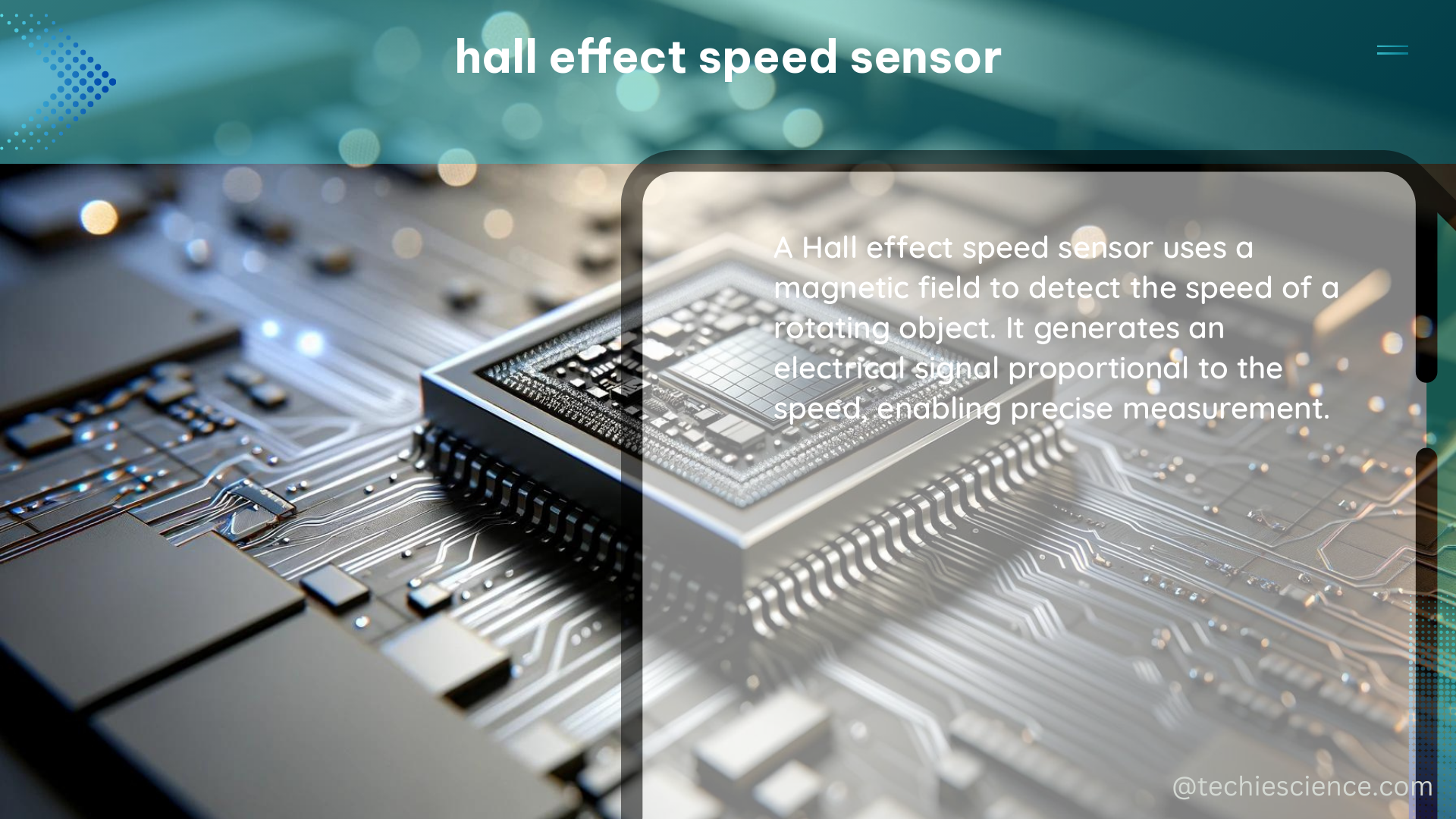The Hall effect speed sensor is a crucial component in modern vehicles, responsible for accurately measuring the speed of a rotating object by detecting the magnetic field generated by a toothed wheel or a magneto-resistive resistor. This sensor generates a voltage proportional to the magnetic field, which is then converted into a digital signal and transmitted to the control unit through a two-pole electric connecting cable. The sensor is designed to operate within a specific voltage range and can be either passive or active, depending on the underlying principle.
Understanding the Technical Specifications of Hall Effect Speed Sensors
The technical specifications of a Hall effect speed sensor can vary depending on the manufacturer and the specific application. However, some common specifications include:
- Operating Voltage: Typical operating voltage ranges from 5V to 24V, with 5V being the most common.
- Operating Temperature Range: Hall effect speed sensors are designed to withstand a wide temperature range, typically from -40°C to +125°C.
- Frequency Range: The frequency range of a Hall effect speed sensor can vary from 10Hz to 10kHz, depending on the application.
- Sensitivity: The sensitivity of a Hall effect speed sensor is typically around 1.5V/kHz, allowing for accurate speed measurements.
- Accuracy: Hall effect speed sensors are known for their high accuracy, with a typical accuracy of ±2%.
Installing and Calibrating Hall Effect Speed Sensors

To properly install and calibrate a Hall effect speed sensor, follow these general steps:
- Locate the Sensor: Identify the location of the Hall effect speed sensor on the vehicle and locate the connecting cable.
- Connect the Sensor: Connect the sensor to the control unit using the provided two-pole electric connecting cable.
- Check the Sensor Signal: Verify the sensor signal using a multimeter or an oscilloscope to ensure proper operation.
- Adjust the Sensor Gap: If necessary, adjust the gap between the sensor and the toothed wheel or magneto-resistive resistor to optimize the sensor’s performance.
- Calibrate the Sensor: Use a diagnostic unit or a specialized tool to calibrate the sensor, ensuring accurate speed measurements.
- Test the Sensor: Test the sensor in different driving conditions and make any necessary adjustments to ensure reliable operation.
Troubleshooting Hall Effect Speed Sensor Failures
When a Hall effect speed sensor fails, it can cause various symptoms, such as:
- Malfunction of the ABS/TCS/ESP braking system
- Illumination of a warning light
- Incorrect speed readings
The common causes of Hall effect speed sensor failure include:
- Damaged Sensor: The sensor itself may be physically damaged, leading to a malfunction.
- Dirty or Corroded Connector: A dirty or corroded sensor connector can disrupt the electrical connection, causing sensor failure.
- Broken Cable: A broken or damaged connecting cable can interrupt the signal transmission between the sensor and the control unit.
- Faulty Control Unit: In some cases, a problem with the control unit can lead to a Hall effect speed sensor failure.
To troubleshoot a Hall effect speed sensor, you can use the following tools:
- Multimeter: To measure the sensor’s voltage, resistance, and continuity
- Ohmmeter: To check the resistance of the sensor and the connecting cable
- Diagnostic Unit: To read and interpret sensor-related diagnostic codes
- Specialized Tools: Such as sensor testers or oscilloscopes, to analyze the sensor’s signal and performance
Advanced Considerations for Hall Effect Speed Sensors
-
Sensor Types: Hall effect speed sensors can be classified into two main types: passive and active. Passive sensors rely on the magnetic field generated by a toothed wheel or a magneto-resistive resistor, while active sensors have an integrated circuit that amplifies and conditions the sensor signal.
-
Sensor Placement: The placement of the Hall effect speed sensor is crucial for accurate speed measurements. The sensor should be positioned in close proximity to the toothed wheel or magneto-resistive resistor, with a carefully maintained gap to ensure optimal performance.
-
Sensor Synchronization: In some applications, multiple Hall effect speed sensors may be used to provide redundancy or to measure the speed of different components. Proper synchronization of these sensors is essential for accurate and reliable speed measurements.
-
Sensor Diagnostics: Advanced diagnostic tools and techniques can be used to analyze the performance of Hall effect speed sensors, including the use of specialized software, sensor testers, and oscilloscopes to identify and troubleshoot issues.
-
Sensor Maintenance: Regular maintenance and inspection of Hall effect speed sensors are crucial to ensure their long-term reliability and performance. This may include cleaning the sensor and its surrounding components, checking for proper gap alignment, and verifying the sensor’s output signal.
By understanding the technical specifications, installation and calibration procedures, troubleshooting methods, and advanced considerations for Hall effect speed sensors, you can ensure the accurate and reliable operation of this critical component in modern vehicles.
References:
- HELLA (2024). Check and change ABS and wheel speed sensors. Retrieved from https://www.hella.com/techworld/us/Technical/Sensors-and-actuators/Check-change-ABS-sensor-4074/
- Eren, S. (2001). Sensing and Sensor Fundamentals. In Sensing and Sensor Fundamentals (pp. 1-28). Springer.
- OLLINTEC (2016). Sensor Technology Handbook. Retrieved from http://ollintec.com/fie/sensores/libros/Sensor%20Technology%20Handbook.pdf

The lambdageeks.com Core SME Team is a group of experienced subject matter experts from diverse scientific and technical fields including Physics, Chemistry, Technology,Electronics & Electrical Engineering, Automotive, Mechanical Engineering. Our team collaborates to create high-quality, well-researched articles on a wide range of science and technology topics for the lambdageeks.com website.
All Our Senior SME are having more than 7 Years of experience in the respective fields . They are either Working Industry Professionals or assocaited With different Universities. Refer Our Authors Page to get to know About our Core SMEs.